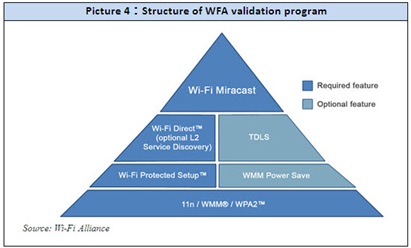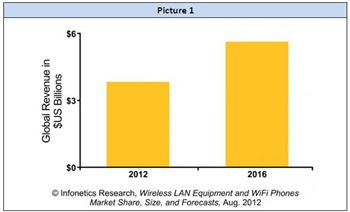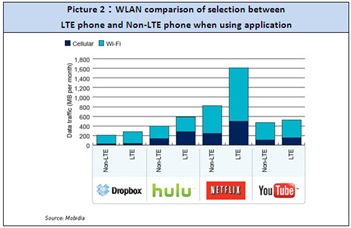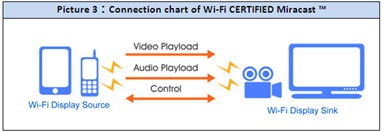Extended collaboration between technology and the content within it shall prevail eventually
According to Marshall McLuhan, a famous Canadian philosopher of communication theory, “All media are extensions of some human faculty- psychic or physical.” From the point of the development of technology, we would realize that with the rise of mobile devices such as smartphone or tablet, it is not only human faculty will be in a phase of re-integration but also extended collaboration between technology itself and the content within it will also enter an era of convergence. In other words, the development of technology and content isn’t just two parallel lines; instead, content can be the extension of technology. For example, we can have better audio-visual feasts through 3D or sound effect. Besides, technology can be the extension of content as well: with the technique of interoperability and compatibility, we will be able to display real-time content on a variety of devices. Therefore, we find out that if content cannot be displayed on diversified platforms, it would obviously interfere with the development of convenience and usability of modern technology. In terms of this, Wi-Fi Alliance® has already launched a whole new certification program in September, called Wi-Fi CERTIFIED Miracast ™. Through Wi-Fi Display technique with simple setting, no matter users are indoor or outdoor, they are able to transmit audio-visual files or pictures quickly between devices that pass Wi-Fi CERTIFIED Miracast ™ certification program, which officially predicts many companies that an era of wireless mobile-display is coming.
Competitive Advantage of Wi-Fi CERTIFIED Miracast ™
Based on the market survey firm Infonetics Research’s latest report (as in picture 1), it indicates that with the progress and the advance of technique and mobile-display, wireless market will have stable scale of growth. In 2016, the total global revenue of WLAN devices and Wi-Fi phones would be 5.6 billion USD. Therefore, Wi-Fi is not only the main access to network data for smartphone users, but also the use for digital information is surprisingly growing, especially in an multimedia-information exploding era. Audio-visual files, entertainment and games and so on all need high-speed transmitting speed and enormous capacity. Besides, many kinds of end-user devices which support Wi-Fi are also popping out, not just only notebook. Currently, smartphone, tablet, smart TV and even digital camera are successively supporting Wi-Fi. No matter in what circumstances, users can interact with Wi-Fi everywhere and at any time, fulfilling an experience of mighty network.
Along with the prosperity of smartphone and application, many users would use cell phones for wireless communication service of audio-visual streaming. In order to assure users of the quality of watching, these media streaming platforms for audio-visual files need more powerful network connection capability. Based on the survey from Informa Telecoms & Media and Mobidia (as in picture 2), when using most of the popular audio-visual streaming service applications in the market such as Youtube, Netflix and Hulu, most of the users use Wi-Fi to connect with. In other words, the combination of wireless technology and audio-visual streaming service is one of the most popular services and development of modern consuming electronic devices, and what Wi-Fi provides with high-speed connection can more straightforwardly satisfy with the urge of large-scale audio-visual files when streaming.
However, due to the feature of portability, smartphone is always restricted to the smaller size of monitor. As a result, more and more smartphone and tablet users would like to transmit and display content like pictures and films on bigger monitors, such as TVs in the living room, as a way to achieve the ideal of watching usability and output interaction between multi-monitors. Therefore, Wi-Fi Alliance® notices the demand of users and is willing to bring the advantage of end-user devices that have Wi-Fi function to connect with each other, having them effectively intercommunicate and share content via seamless wireless network. No matter what brands, sizes, surfaces or content, it is possible to fulfill the intercommunication of Wi-Fi real-time audio-visual entertainment, without complicated setting. The purpose of establishing Wi-Fi CERTIFIED Miracast ™ technology is not only applying Wi-Fi Display in interactive audio-visual entertainment but also simultaneously synchronizing and sharing compatible audio-visual files between devices.
According to the White Paper of Wi-Fi CERTIFIED Miracast™ by Wi-Fi Alliance®, Wi-Fi CERTIFIED Miracast™ product connects with each other via Wi-Fi CERTIFIED Wi-Fi Direct™ technique and no need to link to Wi-Fi network or . In other words, device that is certified by Wi-Fi CERTIFIED Miracast™ has the Wi-Fi ability to connect directly and is not necessary to use existent access point. In terms of technique, Wi-Fi CERTIFIED Miracast™ platform mainly relies on a transmitting end (Source device: Wi-Fi device that is able to transmit multimedia content, such as smartphone or tablet) and a receiving end (Sink device: Wi-Fi device that is able to receive multimedia content, such as TV or projector), building up a P2P connection to achieve the application of wireless audio-visual streaming interaction and convenience(as in picture 3), and thus to upgrade the end-user’s using experience. For example, user can display photos, films or audio-visual media streaming service completely via cell phone on the TV’s big monitor. On the contrary, user can also straightforwardly watch content of TV or PC via cell phone or tablet.
On the bright side, we can say that Wi-Fi CERTIFIED Miracast™ is a technique to intercommunicate with all content via wireless network to continually display pictures, audio-visual content between different Wi-Fi devices, making digital home possible. Besides, setting is very easy: only have to pair two Wi-Fi devices and user can immediately choose content to transmit or display content from original monitor on another monitor. All Wi-Fi CERTIFIED Miracast™ certified devices would automatically recognize and connect to another one and totally no need a third cable, connecter or manual re-setting.
Requirement for Wi-Fi CERTIFIED Miracast™ Certification and Validation
Based on Wi-Fi Display technique, Wi-Fi Alliance® establishes Wi-Fi CERTIFIED Miracast™ certification program. So, basically Wi-Fi CERTIFIED Miracast™ is based on Wi-Fi technique. Devices that are Wi-Fi CERTIFIED Miracast™ certified mostly keep Wi-Fi CERTIFIED Miracast™ product’s joint usability, interoperability and safety. In the coming future, whether at home or at work, for end-user devices that support audio-visual play function such as smartphone, TV, projector, tablet, notebook or digital camera, all have to pass Wi-Fi CERTIFIED Miracast™ certification program, in order to make sure the Miracast™ function is in full play, including monitor and main equipment.
According to Wi-Fi Alliance®, “Wi-Fi CERTIFIED Miracast™ adopts many famous and dependable techniques from Wi-Fi, including Wi-Fi CERTIFIED n (mproved throughput and coverage), Wi-Fi Direct™ (device-to-device connectivity), Wi-Fi Protected Access®2(WPA2™, safety protection/ security), Wi-Fi Multimedia™ (WMM®, traffic management)) and Protected Setup™ and so on. Besides, some Wi-Fi CERTIFIED Miracast™ devices also support TDLS (Tunneled Direct Link Setup), making these devices connect with each other via basic network. What is different from traditional basic network is that TDLS supports high-efficient data transmission and also advanced application of Wi-Fi function.”
As a result, since Wi-Fi CERTIFIED Miracast™ certification program is based on the technical standards and legacy infrastructure network as mentioned above (as in picture 4), it is necessary to take a certain level of connection speed and reliability of safety connection into consideration. As for companies, when companies want their Wi-Fi products to get Wi-Fi CERTIFIED Miracast™ certification, their products are required to pass Wi-Fi CERTIFIED n, Wi-Fi Protected Access®2 and Wi-Fi Direct™ certifications. And TDLS is optional, depending on companies’ demands. Currently, in terms of the speed of transmitting, products that are able to go through Wi-Fi CERTIFIED Miracast™ certification program are products of Wi-Fi CERTIFIED n, others like a, b, g are all unavailable for Wi-Fi CERTIFIED Miracast™ certification program due to it’s speed limitation.

In nowadays modern technology society, smartphone is the fastest growing and developing device, but there is no denying that its small-sized monitor is always an issue. Moreover, the huge demands of multimedia audio-visual streaming applications also indirectly indicate that users are craving for the presentation of audio-visual content and quality. Capability of transmitting content from cell phone to bigger monitor without any difficulties has been a breakthrough that every technical standard is working on, such as Miracast™, MHL and MyDP. As a certified lab by every technical standard alliance, Allion here presents a simple chart (as in chart 1), from the point of a professional validation lab. Both company and user can choose different technical standards to achieve mobile display connect technology according to its own purpose of using. Allion offers one-step three standard-validation services of these three emerging and promising new technologies.
| Chart 1:Technical comparison between Miracast, MHL and MyDP | |||
| Technical Specification | Miracast | MHL | MyDP |
| Association | Wi-Fi Alliance | MHL Consortium | VESA |
| Base of standard technique | Wi-Fi | HDMI、Micro USB | DisplayPort |
| Maximum speed of transmission | Based on 11n, depends on different specification of device | 2.25Gbp | 5.4 Gbps |
| Supporting audio-visual specification | - 17 Consumer Electronics Association (CEA)format, from 640 x 480 up to 1920 x 1080 pixels
- 30 Video Equipment Standards Association (VESA)format, form from 800 x 600 up to 1920 x 1200 pixels - 12 handheld formats, from 640 x 360 up to 960 x 540 pixels |
- 11080p HD Video
- 77.1 Digital Audio - 11080p/30Hz |
- 11080p HD Video
- 77.1 Digital Audio - Support Full HD 1,080p/60Hz display |
| Connection method | Wireless | Wire | Wire |
| Charging function | No | Yes | Yes |
| Digital pins on mobile phone | No | Micro USB 5 pin | At least has 5pin digital surface |
| Connection pins on TV | No | HDMI 19 pin | Via passive/active cable/cable adaptor, standard DP and miniDP.
Via MyDP active converter, HDMI/VGA. |
As the brand new certification program launched by Wi-Fi Alliance®, the purpose of Wi-Fi CERTIFIED Miracast™ is to make sure the tested product is able to correctly adopt the technical specification of Wi-Fi Display. Wi-Fi CERTIFIED Miracast™ certified devices are able to transmit audio-visual files to compatible devices via Wi-Fi. Devices like TV, set-up box, notebook, hand-carry device, and tablet are considered to be the first product that would adopt this wireless audio-visual technique. Allion is the first wave of ATL (Authorized Test Laboratory) to conduct Wi-Fi CERTIFIED Miracast™ Program. The service coverage will include the standard certification testing, device interoperability, debugging support, and technical consultation. To obtain further info or if you need a prompt response regarding this program, please contactservice@allion.com.









































